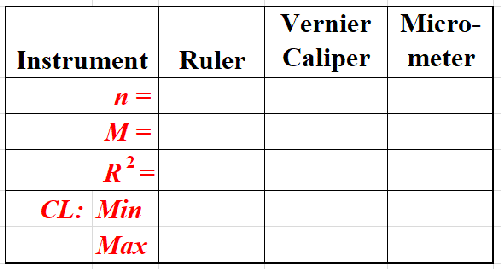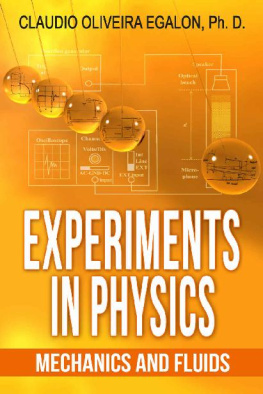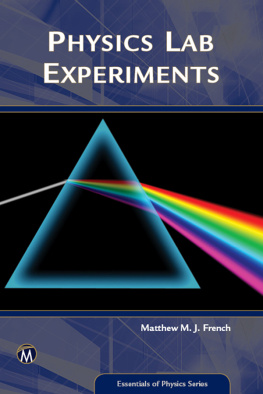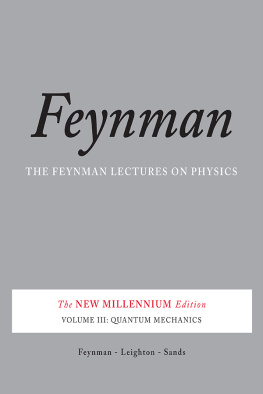Claudio Oliveira Egalon [Egalon - Mechanics: Experiments in Physics
Here you can read online Claudio Oliveira Egalon [Egalon - Mechanics: Experiments in Physics full text of the book (entire story) in english for free. Download pdf and epub, get meaning, cover and reviews about this ebook. year: 2015, publisher: Claudio Oliveira Egalon, genre: Computer. Description of the work, (preface) as well as reviews are available. Best literature library LitArk.com created for fans of good reading and offers a wide selection of genres:
Romance novel
Science fiction
Adventure
Detective
Science
History
Home and family
Prose
Art
Politics
Computer
Non-fiction
Religion
Business
Children
Humor
Choose a favorite category and find really read worthwhile books. Enjoy immersion in the world of imagination, feel the emotions of the characters or learn something new for yourself, make an fascinating discovery.
- Book:Mechanics: Experiments in Physics
- Author:
- Publisher:Claudio Oliveira Egalon
- Genre:
- Year:2015
- Rating:5 / 5
- Favourites:Add to favourites
- Your mark:
- 100
- 1
- 2
- 3
- 4
- 5
Mechanics: Experiments in Physics: summary, description and annotation
We offer to read an annotation, description, summary or preface (depends on what the author of the book "Mechanics: Experiments in Physics" wrote himself). If you haven't found the necessary information about the book — write in the comments, we will try to find it.
Claudio Oliveira Egalon [Egalon: author's other books
Who wrote Mechanics: Experiments in Physics? Find out the surname, the name of the author of the book and a list of all author's works by series.
Mechanics: Experiments in Physics — read online for free the complete book (whole text) full work
Below is the text of the book, divided by pages. System saving the place of the last page read, allows you to conveniently read the book "Mechanics: Experiments in Physics" online for free, without having to search again every time where you left off. Put a bookmark, and you can go to the page where you finished reading at any time.
Font size:
Interval:
Bookmark:
MECHANICS:
EXPERIMENTS IN PHYSICS
Published by Claudio Oliveira Egalon
Copyright 2014-2018
by Claudio Oliveira Egalon
Version 24
09/12/2018
This ebook is licensed for your personal enjoyment only. This ebook may not be resold or given away to other people. If you would like to share this book with another person, please purchase an additional copy for each recipient. If you are reading this book and did not purchase it, or it was not purchased for your use only, then please return to your favorite ebook retailer and purchase your own copy. Thank you for respecting the hard work of this author.
TABLE OF CONTENTS
DIFFERENT SIZES AND SAME MATERIAL
Introduction
In this experiment you will learn how to make measurements with the Ruler, Vernier caliper and the micrometer. You will also learn how to report the right number of digits of your measurements and results, the so-called Significant Digits. You should review Appendix II at the end of this manual to learn how to report the right number of significant digits.
Equipment
Ruler; Vernier caliper; micrometer; scale; spheres of different sizes made of the same material.
Procedure
Before proceeding, you must first become thoroughly familiar with the handling of Significant Figures as described in Appendix II. Please review this Appendix before proceeding.
Table 0-1. Theoretical values of the density.

Experimental Procedure: Spheres of the same Material Having Different Sizes
- Select six spheres of different dimensions made from the same material.
- Identify the type of materials you are working with and log them in Table 0-1.
- Using your Physics book, consult the density of the material and log this value in Table 0-1.
- Measure the mass and diameter of the spheres and log these values in Table 0-2.
- In the row for Units of Table 0-1 ALWAYS use the main units of the SI system: m for meter and kg for kilogram.
- In the conversion factor row, use the number 0.01 if your measurement is reported in centimeter and 0.001 if your measurement is reported in mm.
Table 0-2. Sphere's Measurements (Diameter and Mass) and Results (Volume).

Calculations and Data Analysis
- Calculate the volumes of the spheres and log them in Tables 0-2.
- Using the data for the mass and volume in Table 0-2, plot three linear graphs: one for the ruler; one for the Vernier caliper and the other for the micrometer. Put the mass in the y -axis and the volume in the x -axis.
- Find the regression equation and the determination coefficient R of the above graphs (see the syllabus on how to do that) and log them in Table 0-3.
- Using the determination coefficient and the number of data points, find the lower and upper values (minimum and maximum values) of the Confidence Level of each curve using the Table of : log these values in Table 0-3.
- The slope of the Regression Equation is the experimental value of the density as determined by each instrument: log these values in Table 0-4 and find their percentage difference with respect to the theoretical value of Table 0-1.
Table 0-3. Results: number of datapoints, n , Regression Equation of the mass M ; Determination Coefficient, R , and Confidence Level, CL, for the spheres.

Table 0-4. Results: Experimental density and their percentage differences.

#
Introduction
This experiment is closely related to Newtons First Law of motion. Accordingly, if the net force in an object is zero, this object will be either at rest or moving with constant velocity. In order to confirm this law, we will use a leveled air track to remove the frictional force between the track and a cart.
Equipment
Air track, spark timer, heat sensitive tape, adhesive tape, air cart (glider), one paper clip, air compressor (one for two groups), hose, rubber bands, string, matches, ruler and meter stick.
Experimental Procedure
- Clean the surface of the air track and the bottom of the glider. Carefully set the glider on the track and do not slide it across the track while the compressor is off . If you do, you will scratch and damage the track surface.
- Connect one end of the hose to the connector at the end of the track and the other end of the hose to the connector of the air pump.
- Turn on the air compressor and level the air track as well as you can. While you adjust the level, the cart should be placed at the very middle of the track. Do not put the cart elsewhere or you will not be able to level the track properly. The cart should either remain at rest or move very slowly.
- After the track is leveled, turn off the air compressor.
- Set the spark timer to 60 Hz and log this value, f = 60 Hz, in Table 1-1. 60 Hz means that you are generating 60 sparks per seconds. Do not turn on the spark timer yet and be careful with it!!! This is a high voltage device that, at best, can scare you and, at worst, can electrocute and really hurt you!
Table 1-1. Data and results.

- With the spark timer off , connect its high voltage terminal (the red cable) to the long wire stretched above the track and along its length. The ground terminal (the black cable) should be connected to the frame of the track. Both cables should be connected to the back of the spark timer. The long wire above the track is electrically insulated from the track frame.
- Fix the thermal paper along the length of the track, just below the glider, with its white surface facing up.
- Stretch the paper clip and attach one of its ends to the body the cart. Bend the paper clip so a short section of it is positioned as close as possible to the track wire without touching it . If the clip touches the wire, friction will be added to the motion of the cart. Ensure that the clip does not touch the wire at any position along the track!!! The other end of the clip should be positioned as close as possible to the thermal paper (again it should not touch it).
- Now that you have the track leveled and the glider, the tape and paper clip mounted on the track, turn the spark timer switch on. At this point, you should move away from the track: do not touch the track surface or the glider otherwise you may be electrocuted !
- The spark timer has a second switch which, when depressed, activates the sparks. The spark rate is adjusted by a knob on the spark timer: set its rate at 60 Hertz.
- With the air compressor still off, depress the second spark timer switch and observe the sparks moving from the upper wire all the way down to the lower clip and the thermal tape. If everything is working correctly, a dark spot will form on the thermal tape surface.
- After you observe the dark spot on the surface of the thermal taper, turn the spark timer off.
- Attach a rubber band to one of the ends of the track so it can be used as a launcher for the cart.
Font size:
Interval:
Bookmark:
Similar books «Mechanics: Experiments in Physics»
Look at similar books to Mechanics: Experiments in Physics. We have selected literature similar in name and meaning in the hope of providing readers with more options to find new, interesting, not yet read works.
Discussion, reviews of the book Mechanics: Experiments in Physics and just readers' own opinions. Leave your comments, write what you think about the work, its meaning or the main characters. Specify what exactly you liked and what you didn't like, and why you think so.









